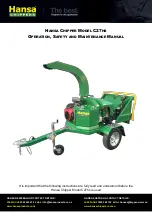
FORM 160.75-O1 (309)
31
JOHNSON CONTROLS
condensers and eVaporators
general
Maintenance of condenser and evaporator shells is im-
portant to provide trouble free operation of the chiller.
The water side of the tubes in the shell must be kept
clean and free from scale. Proper maintenance such as
tube cleaning, and testing for leaks, is covered on the
following pages.
chemical Water treatment
Since the mineral content of the water circulated through
evaporators and condensers varies with almost every
source of supply, it is possible that the water being used
may corrode the tubes or deposit heat resistant scale in
them. Reliable water treatment companies are available
in most larger cities to supply a water treating process
which will greatly reduce the corrosive and scale form-
ing properties of almost any type of water.
As a preventive measure against scale and corrosion and
to prolong the life of evaporator and condenser tubes, a
chemical analysis of the water should be made preferably
before the system is installed. A reliable water treatment
company can be consulted to determine whether water
treatment is necessary, and if so, to furnish the proper
treatment for the particular water condition.
cleaning eVaporator and condenser tuBes
Evaporator
It is difficult to determine by any particular test whether
possible lack of performance of the water evaporator
is due to fouled tubes alone or due to a combination
of troubles. Trouble which may be due to fouled tubes
is indicated when, over a period of time, the cooling
capacity decreases and the split (temperature differ-
ence between water leaving the evaporator and the
refrigerant temperature in the evaporator) increases. A
gradual drop-off in cooling capacity can also be caused
by a gradual leak of refrigerant from the system or by a
combination of fouled tubes and shortage of refrigerant
charge. An excessive quantity of oil in the evaporator
can also contribute to erratic performance.
Condenser
In a condenser, trouble due to fouled tubes is usually
indicated by a steady rise in head pressure, over a period
of time, accompanied by a steady rise in condensing
temperature, and noisy operation. These symptoms may
also be due to foul gas buildup. Purging will remove the
foul gas revealing the effect of fouling.
tuBe fouling
Fouling of the tubes can be due to deposits of two types
as follows:
1.
Rust or sludge
– which finds its way into the tubes
and accumulates there. This material usually does not
build up on the inner tube surfaces as scale, but does
interfere with the heat transfer. Rust or sludge can
generally be removed from the tubes by a thorough
brushing process.
2.
Scale
– due to mineral deposits. These deposits, even
though very thin and scarcely detectable upon phys-
ical inspection, are highly resistant to heat transfer.
They can be removed most effectively by circulating
an acid solution through the tubes.
tuBe cleaning procedures
Brush Cleaning of Tubes
If the tube consists of dirt and sludge, it can usually be
removed by means of the brushing process. Drain the
water sides of the circuit to be cleaned (cooling water
or chilled water) remove the heads and thoroughly clean
each tube with a soft bristle bronze or nylon brush.
DO
NOT USE A STEEl BRiSTlE BRUSh
. A steel brush
may damage the tubes.
Improved results can be obtained by admitting water into
the tube during the cleaning process. This can be done by
mounting the brush on a suitable length of 1/8" pipe with a
few small holes at the brush end and connecting the other
end by means of a hose to the water supply.
The tubes should always be brush cleaned before acid
cleaning.
acid cleaning of tuBes
If the tubes are fouled with a hard scale deposit, they
may require acid cleaning. It is important that before acid
cleaning, the tubes be cleaned by the brushing process
described above. If the relatively loose foreign material
is removed before the acid cleaning, the acid solution will
have less material to dissolve and flush from the tubes
with the result that a more satisfactory cleaning job will
be accomplished with a probable saving of time.
Acid cleaning should only be performed
by an expert. Please consult your local
water treatment representative for as-
sistance in removing scale buildup and
preventative maintenance programs to
eliminate future problems.
6
Summary of Contents for York MaxE YK Series
Page 2: ...Page 2 of 2 ...
Page 3: ......
Page 4: ......
Page 5: ......
Page 6: ......
Page 7: ......
Page 8: ......
Page 9: ......
Page 10: ......
Page 11: ......
Page 12: ......
Page 13: ......
Page 14: ......
Page 15: ......
Page 16: ......
Page 17: ......
Page 18: ......
Page 19: ......
Page 20: ......
Page 21: ......
Page 22: ......
Page 23: ......
Page 24: ......
Page 25: ......
Page 26: ......
Page 27: ......
Page 28: ......
Page 29: ......
Page 30: ......
Page 31: ......
Page 32: ......
Page 33: ......
Page 34: ......
Page 35: ......
Page 36: ......
Page 37: ......
Page 38: ......
Page 39: ......
Page 40: ......
Page 41: ......
Page 42: ......
Page 43: ......
Page 44: ......
Page 45: ......
Page 46: ......
Page 47: ......
Page 48: ......
Page 49: ......
Page 50: ......
Page 51: ......
Page 52: ......
Page 53: ......
Page 54: ......
Page 55: ......
Page 56: ......
Page 57: ......
Page 58: ......
Page 59: ......
Page 60: ......
Page 61: ......
Page 62: ......
Page 63: ......
Page 135: ...JOHNSON CONTROLS FORM 160 75 O1 309 36 SI metric conversion ...
Page 137: ...JOHNSON CONTROLS FORM 160 75 O1 309 38 NOTES ...
Page 138: ...FORM 160 75 O1 309 39 JOHNSON CONTROLS NOTES ...










































